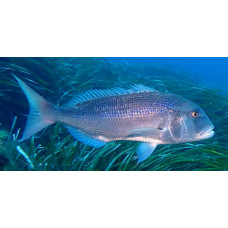Latin name
Dentex dentex
Other names
Dentali (Albanian), Zuban (Bulgarian), Tandbrasem (Dutch), Συναγρίδα (Synagrida) (Greek), Shenun (Hebrew), Dentón (Spanish), Dentice (Italian), Zahnbrasse (German), Kielec własciwy (Polish), Dentao (Portuguese), Dințat (Romanian), Zubatac (Serbian, Croatian), Zobatec (Slovenian), Sinarit (Turkish), Denté commun (French).
Identification
Body oval in shape, compressed at the sides. The lateral line organ is clearly visible on the sides of the body. The profile of the head is slightly convex in adults and almost straight in juveniles. Mouth horizontal, not very large. The canine teeth are arranged in several rows. The teeth in the anterior rows are stronger than those in the posterior rows, with 4-6 fangs on each jaw in the first row. The upper part of the first gill arch has 9-10 gill stamens and the lower part has 8-9 stamens. There are 62-68 scales on the lateral line.
Features of fish fins
The dorsal fin has 11 barb rays and 11-12 soft rays. The barbs on the dorsal fin may be hidden in a recess on the back of the fish. The anal fin has 3 barb rays and 7-9 soft rays.
Fish colouring
The back is greyish-blue, the sides are silver with bluish spots. The dorsal fin is bluish-yellow and the pectoral fins are reddish. Adults have a large yellow spot on the lower part of the gill cover. Juveniles are grey with dark spots on the upper part of the body.
Distribution
Occurs in the eastern Atlantic, Mediterranean and Black Seas. A permanent resident of the Adriatic.
Habitat
Littoral benthopelagic fish, inhabiting depths down to 200m on rocky and sandy substrates with seagrass thickets (genera Posidonia, Caulerpa and Cymodocea), most commonly found at depths of 15-50 m.
Size
Maximum length about 1 m, usually 35-50 cm; body mass up to 14.3 kg.
Behavior
Adults are solitary. Juveniles live in shallow water to a depth of 4m and form small schools. Active predators.
Food and feeding habits
It feeds on molluscs, cephalopods, small fish (Black Sea sprat, European anchovy, sprat). Juveniles feed on plankton, larvae and eggs of other fish.
Reproduction
Usually unisexual, but hermaphroditic individuals are found in the Mediterranean. Matures at 2-4 years of age. In the Balearic Islands, the body length of 50% of mature individuals is 36.4 cm for females and 52 cm for males; in the coastal waters of Tunisia, these figures are 23.3 cm for males and 22.6 cm for females. During the spawning season, gather in small shoals. They spawn at depths of 40-100m near rocky outcrops between late March and May, usually during the day, although night spawning has been observed during full moons.
Eggs are pelagic, spherical and 1.2 mm in diameter. After hatching, the larvae have a body length of 3.8 m. Rapid growth is observed in the first two years of life, with individuals reaching a length of 24 cm in one year, after which the growth rate slows sharply. The maximum life span is estimated to be 20 years.
Fishing
Target of commercial, artisanal and recreational fishing. The meat is rich in phosphorus, potassium, sulphur, iodine, vitamins E and B2.
| Classification | |
| Phylum | Chordata |
| Class | Actinopterygii |
| Squad | Spariformes |
| Family | Sparidae |
| Genus | Dentex |
| Species | D. dentex |
| Features | |
| Conservation status | Vulnerable |
| Habitat | Pelagic |
| Life span, years | 20 |
| Maximum body weight, kg | 14,3 |
| Maximum length, cm | 100 |
| Sailing speed, m/s | No information |
| Threat to people | Edible |
| Way of eating | Predator |
Common Dentex
Tags: common dentex



